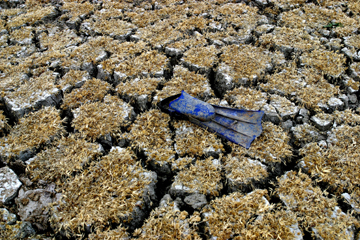 Or the part of the Parker County peach crop that didn’t make last year because there wasn’t enough cool weather. Or the banana crop in Bob Randall’s Houston garden. But they may be as important a set of indicators of Texas’ future as any canary in a coal mine. The parched and pitiful state of so many North Texas lakes, on the other hand, even after a relatively rainy stretch, is perhaps easier to see as part of a larger weather puzzle — and it’s certainly not hard for Texas farmers and ranchers, who are still weathering a drought that, to one degree or another, has persisted here since the 1980s. Anyone with a thermometer — or a garden or a bill to pay for air conditioning — could register the record-breaking summer heat that much of Texas suffered last year. Then there were Katrina and Rita, the mega-hurricanes that painted the proof of their violence all across the Gulf Coast in 2005 and brought some of their rain and thousands of their refugees to the Metroplex.
Or the part of the Parker County peach crop that didn’t make last year because there wasn’t enough cool weather. Or the banana crop in Bob Randall’s Houston garden. But they may be as important a set of indicators of Texas’ future as any canary in a coal mine. The parched and pitiful state of so many North Texas lakes, on the other hand, even after a relatively rainy stretch, is perhaps easier to see as part of a larger weather puzzle — and it’s certainly not hard for Texas farmers and ranchers, who are still weathering a drought that, to one degree or another, has persisted here since the 1980s. Anyone with a thermometer — or a garden or a bill to pay for air conditioning — could register the record-breaking summer heat that much of Texas suffered last year. Then there were Katrina and Rita, the mega-hurricanes that painted the proof of their violence all across the Gulf Coast in 2005 and brought some of their rain and thousands of their refugees to the Metroplex.
Scientists, especially those who measure weather, a phenomenon that can’t be duplicated and dissected under controlled laboratory conditions, don’t like to point to a particular heat wave or dry lake bed or single storm and say, “There is global warming.” But they do say this: Make no mistake about it, even if Texas’ top government officials are still playing see-no-evil, hear-no-evil, global warming isn’t just something to worry about for the future or something happening to the polar ice cap. It’s what’s happening here, today. “It’s really just a matter of time before we see effects here that can unambiguously be related to global warming,” said Dr. Andy Dessler, of Texas A&M University’s atmospheric sciences department. “The scientific community is very united,” said Dessler, a former White House policy analyst on science and technology. “Climate change is happening. There is no question that humans are contributing to the globe’s warming, and it’s likely that humans are now the dominant drivers of the climate. We’re in the driver’s seat.”
In Texas, many horticulturalists and scientists say they’ve already seen changes in the growing seasons that are important in terms of what can be grown where. Sea levels, already rising along the coast, are predicted to gain as much as 10 feet over the next century — though even three feet would leave South Padre Island and much of Galveston under water. The insurance industry is calling for more preparation to help reduce the effects of the stronger storms that many scientists say are another calling card of global warming. Despite all that, and a scientific consensus thicker than what’s left of the polar ice cap, Gov. Rick Perry told the Fort Worth Star-Telegram last week that global warming is not sufficiently well established to be a basis for state policy. Lt. Gov. David Dewhurst also was quoted as saying there was no scientific consensus.
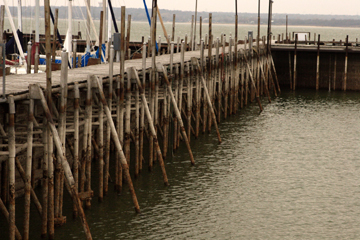 But around the state, widely diverse groups of Texans — from church congregations to mayors to the insurance industry, and even some state agencies — are uncovering their eyes and taking hands away from their ears. They are dealing with the results of climate change, doing what they can to slow it down, and working to get the state off the high — and increasingly hot — center where Perry and others have left it, to begin the work of reducing Texas’ very heavy contributions to global warming. They can already see the looming effects on the state’s economy of the warming phenomenon — and the financial gains to be reaped from addressing, rather than ignoring, the problem. “This is an issue whose time has come in Texas,” said Houston activist Nan Hildreth. “I’m surprised at how quickly the issue has moved in the last year.”
But around the state, widely diverse groups of Texans — from church congregations to mayors to the insurance industry, and even some state agencies — are uncovering their eyes and taking hands away from their ears. They are dealing with the results of climate change, doing what they can to slow it down, and working to get the state off the high — and increasingly hot — center where Perry and others have left it, to begin the work of reducing Texas’ very heavy contributions to global warming. They can already see the looming effects on the state’s economy of the warming phenomenon — and the financial gains to be reaped from addressing, rather than ignoring, the problem. “This is an issue whose time has come in Texas,” said Houston activist Nan Hildreth. “I’m surprised at how quickly the issue has moved in the last year.”
Texas is the number-one greenhouse-gas-producing state in the country, producing more carbon dioxide (a major contributor to global warming) than all but six independent countries. Unfortunately, the Lone Star State is at the other end of the list on working to combat the problem: At last count, 16 other states have begun work to reduce carbon emissions and otherwise address global warming, even without the federal government’s help. That also means that the work that Texans do on this issue, if it results in major changes in the state’s greenhouse emissions, could literally help cool the world, and failure to act could help fry it up faster. Take Perry’s freight-train move to get a total of 19 new coal-fired utility plants approved before limits are placed on carbon dioxide emissions — a move that environmentalists, a mayors’ coalition (though Fort Worth’s mayor hasn’t signed on), and even some major business leaders are trying to sidetrack. Those plants, said Tom “Smitty” Smith, director of Public Citizen’s Texas office, would add as much global warming pollution as all the cars in Texas — “and those impacts will continue each and every year for the next 50,” he said. “That’s a decision we’re going to make.”
Or as hydrologist Ranjan Muttiah, at Texas Christian University, puts it, “Anything we do here [regarding greenhouse gases] affects the rest of the world. If Texas cuts greenhouse emissions in half or doubles them, it has a direct effect above the Arctic circle and on people in Africa.” Bee Moorhead is executive director of Texas Interfaith Power and Light, a nonprofit network of more than 150 Texas religious congregations that is spreading the gospel of action against global warming. She believes people are more convinced every day that global warming is real — but once they accept that, she said, too many leap right over action into fatalism, assuming the problem is so large they can’t do anything about it. “Despair is the biggest problem,” she said. “But if there is any one institution in our society whose whole job it is to combat despair, it is for sure the religious community. And they are stepping up to deal with this issue.”
The problem with peaches last year, Dottie Woodson said, wasn’t so much how hot it got as how cold it didn’t get. She’s the Tarrant County extension agent for horticulture. “The thing I see mostly in the Metroplex” in terms of climate change affecting plants, she said, “is like last summer, when we had apple and peach crop failures because we didn’t get enough chilling hours.” At a recent meeting with farmer’s market participants, she said, growers were worrying out loud about the same thing happening this year — but that was before a recent cold snap. One year when some peach varieties don’t make a crop doesn’t make a trend, but the changes in plant life here mirror what’s going on around the state — and has been going on gradually now for years. Dr. Muttiah said invasive species, like mesquite and salt cedar, have been making headway in this area for decades, often moving in to farms that have succumbed to drought.
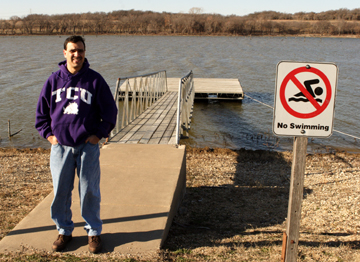 Not every nursery owner in Fort Worth believes that the recent weather changes are part of global warming. But Randy Weston, co-owner of Weston Gardens, said he’s seen long-term changes, even though he tends to stock hardy native plants that do well in the heat and with minimal watering. “The biggest effect I’ve seen in the 20-plus years we’ve been in the business is that the season gets longer in terms of the heat and the night stays warmer deep into the night,” he said. “Just in the last five to seven years, I’ve seen a pronounced effect as the temperatures hang on deeper into the evening, even in October,” which stresses plants by giving them less time to cool off. Even with native plants, he said, “that sends them into dormancy earlier.” A long-term change toward hotter weather “might give people a little more urge to experiment” with things like mountain laurels — or even palm trees, in protected places, he said. Other plant nursery operators in town also said they’ve heard more and more in recent years from folks who say plants like begonias are surviving outside through the winter — well, through some North Texas winters.
Not every nursery owner in Fort Worth believes that the recent weather changes are part of global warming. But Randy Weston, co-owner of Weston Gardens, said he’s seen long-term changes, even though he tends to stock hardy native plants that do well in the heat and with minimal watering. “The biggest effect I’ve seen in the 20-plus years we’ve been in the business is that the season gets longer in terms of the heat and the night stays warmer deep into the night,” he said. “Just in the last five to seven years, I’ve seen a pronounced effect as the temperatures hang on deeper into the evening, even in October,” which stresses plants by giving them less time to cool off. Even with native plants, he said, “that sends them into dormancy earlier.” A long-term change toward hotter weather “might give people a little more urge to experiment” with things like mountain laurels — or even palm trees, in protected places, he said. Other plant nursery operators in town also said they’ve heard more and more in recent years from folks who say plants like begonias are surviving outside through the winter — well, through some North Texas winters.
Weston and Woodson both noticed the new “hardiness zone” map put out recently by the National Arbor Day Foundation, which gives gardeners a rough guide to what can safely be planted in what part of the country. The U.S. Department of Agriculture used to update that map every 10 years, but hasn’t done so since 1990 — for political reasons, some environmentalists believe. So the Arbor Day folks did it themselves, based on the same kinds of data that the USDA always used in the past. The new map shows big changes. “Significant portions of many states have shifted at least one full hardiness zone,” an Arbor Day Foundation news release said. “Some areas around the country have even warmed two full zones.” “This has enormous practical implications for anybody who grows plants,” said Bob Randall, executive director of Houston’s Urban Harvest, a nonprofit group that works with community and school gardeners using organic and sustainable techniques. Farmers and gardeners need to know not only what the average temperatures in an area are likely to be, he said, but the number of “chill” hours needed for some crops to produce and the number of really cold days.
In Houston, he said, “there are significant parts of the city that haven’t had a frost in quite a long time. In some Galveston beach areas, they haven’t had temperatures below 40 in recent years.” Houston generally has gone from having typical low temperatures of 25 or 26 in the winter to lows of 30 or 31, he said. “If you put them on the warm side of your house, you can actually get mangoes [to thrive] through the winters” now, which would have been unheard-of in the past, Randall said. And banana trees are actually making a delicious crop in the city now. “We are looking at some very strange things,” he said. Even though the Earth’s climate system is hugely complex, Andy Dessler figures that scientists have a pretty good idea what will happen over the next 50 to 150 years, as greenhouse gases keep much of the planet’s heat from radiating back out into space. “It’s obvious that temperatures will go up, there’s no question about that,” Dr. Dessler said. “Precipitation patterns will change. Both of those things will have strong impacts on human health. Air quality will degrade as things get hotter. Heat waves are likely to be longer and hotter and more frequent. And that’s going to increase heat-related deaths.” Many observers also predict that wildfires will be an increasing problem, as they have been in the western United States in recent years.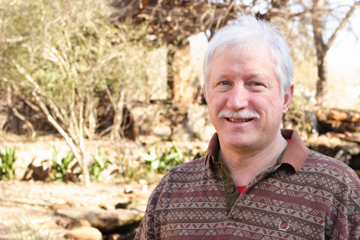
But the most important near-term effect that global warming is likely to have on Texas and elsewhere, he said, “is changes in fresh water availability.” Global warming, he said, is likely to affect that in two ways: First, there’s likely to be more overall precipitation. But second, it’s likely to come in fewer events. “So it’s a paradoxical situation, with an increased risk of both flooding and drought,” he said. With that kind of pattern, regular flow in many streams could drop significantly. “We can live if the temperature increases — humans are quite resilient to heat. But people cannot live without water,” Dessler said. The rough rule, he said, is that it takes about 100 tons of water to produce a ton of food — so big changes in rainfall patterns “will start putting pressure on our food supply.” In Texas, Dessler said, farmers and ranchers and their customers may be able to adapt without too much agony. “But in many places in the world, they just don’t have the resources to do that. I think in the next few decades we will start seeing wars [being fought] over water.”
Closer to home, “many parts of Texas are already acutely water-stressed,” he said. And the zooming rates of development around many cities are increasing the pressure on water supplies, in some cases lowering aquifer levels and lake levels significantly, and causing water agencies to go farther and farther afield for municipal water supplies. If rainfall decreases by, say, another 20 percent, Dessler said, “that could be a really hard problem to solve. And it’s really likely that that’s going to happen.” Even though Perry and some other state leaders don’t want to talk about it, state agencies like the Texas Water Development Board are at least giving a nod to the problem. The state’s water development plan notes that nine of the 10 hottest years on record have taken place in the past decade, and that many areas of the world are experiencing increased precipitation. However, the document immediately lapses back into the no-worry mode. “The effects of climate change on the state’s water resources over the next 50 years is probably small enough that it is unnecessary to plan for it specifically,” it says.
At TCU, Muttiah has studied the effects of climate change on water supplies — a critical issue, he said, since Texas and much of the western United States is still suffering from a drought that started in the 1980s and that appears to be worse than the one in the ’50s that drove many Texas farmers and ranchers out of business. Muttiah said that the climate models are showing that storms are likely to be more intense as the climate warms up — in part because a warmer climate will increase evaporation rates, thus fueling the ocean heat engines that produce hurricanes. As storms get worse, he said, Gulf Coast residents are likely to see more Level 4 and Level 5 hurricanes. Stronger storms like Katrina and Rita “can go deep inland,” he said, and cities such as Fort Worth and Dallas need to consider whether their flood levees, designed to withstand a certain level of storm, will hold up in the future. Muttiah, like many others involved with this issue, said that changes in society that lessen greenhouse gas emissions can definitely have an impact on global warming, even if climate trends can’t be reversed or affected immediately.
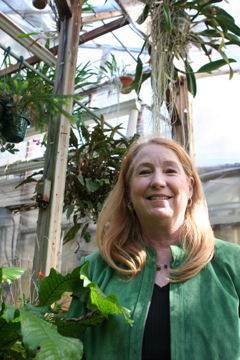 Whenever climate-change researchers get together, he said, “one thing we always talk about is how this kind of issue is not noticed until something like a 9/11 of climate change happens — until something hits them at the homefront.” But noticing, and doing something about it, is critical, he said — so critical that the scientists who keep the “doom clock” have reset it closer to midnight, in part because of global warming. Dessler likened the global climate apparatus to a fully loaded super-tanker under way — it doesn’t turn very fast, but it can be steered. Many global warming-related changes are still decades away, he said — but “we have to start acting now to change the course early. If we wait until the rocks are right ahead, we won’t be able to turn it.” Like a growing coalition of environmental groups, clean-air supporters, mayors, and business leaders, Dessler said a first step that Texas should take “would be to not build all these coal-fired power plants. It’s morally bankrupt and bad policy.” The plants could become very expensive albatrosses around Texas energy consumers’ necks, if the plants cannot meet future standards regulating carbon emissions. What’s more, he said, “Texas is generating a lot of ill will among other states” that are actively working to reduce their own greenhouse emissions while Texas emission levels continue to increase. “That’s going to come back to haunt us,” he said.
Whenever climate-change researchers get together, he said, “one thing we always talk about is how this kind of issue is not noticed until something like a 9/11 of climate change happens — until something hits them at the homefront.” But noticing, and doing something about it, is critical, he said — so critical that the scientists who keep the “doom clock” have reset it closer to midnight, in part because of global warming. Dessler likened the global climate apparatus to a fully loaded super-tanker under way — it doesn’t turn very fast, but it can be steered. Many global warming-related changes are still decades away, he said — but “we have to start acting now to change the course early. If we wait until the rocks are right ahead, we won’t be able to turn it.” Like a growing coalition of environmental groups, clean-air supporters, mayors, and business leaders, Dessler said a first step that Texas should take “would be to not build all these coal-fired power plants. It’s morally bankrupt and bad policy.” The plants could become very expensive albatrosses around Texas energy consumers’ necks, if the plants cannot meet future standards regulating carbon emissions. What’s more, he said, “Texas is generating a lot of ill will among other states” that are actively working to reduce their own greenhouse emissions while Texas emission levels continue to increase. “That’s going to come back to haunt us,” he said.
Officials of TXU, the giant electric utility that is seeking to build 11 of those plants, have said that the proposed plants will be some of the cleanest-burning in the country, and that because older plants will be taken out of service, the overall impact on air quality will be neutral. Nonetheless, some legislators are trying to take those plants off the fast track. In late January, State Rep. Lon Burnam of Fort Worth filed a bill that would establish a task force to assess the economic and public health impacts of global warming in Texas. Despite the fact that Texas has 600 miles of coastline threatened by warming-induced flooding, he said, “the state is like the proverbial ostrich with its head in the sand. We need a plan to deal with this challenge.” Burnam said that, because people from all parts of the political spectrum are waking up to the dangers posed by global warming, his bill should have a better chance of passing than in previous years. He noted that a bipartisan Clean Air Caucus has been created in the legislature this session. Still, the Democrat said, since he’s “not allowed to pass legislation [due to] previous sins” against Texas House Speaker Tom Craddick, it may take a Republican filing an identical bill to get it passed.
The Fort Worth legislator and others made the point that addressing global warming doesn’t mean simply putting more onerous regulations on business. Burnam said he wants the task force to “seek opportunities for businesses that do the right thing.” As low-emission technologies, for instance, come into more widespread use, some experts said, their costs will drop, and the provision of those new technologies could create new businesses and industries. Strategies to reduce Texans’ energy use not only help limit greenhouse emissions and other forms of air pollution, said Smith, the Public Citizen director, but “many solutions to global warming put money in our pockets.” He expects major efforts in the legislature this session to find ways to generate energy from renewable and cleaner sources, “as a way of reducing the need for those coal-fired plants.” Smith said Texas needs to recreate the sustainable energy development council that was inaugurated by Gov. Ann Richards, but that was abolished, he said, when George Bush became governor. The council “blueprinted the transition to a carbon-neutral economy. They found we could make a lot of money if we just made the transition to clean energy.” Many lessons learned from that study “turned into the wind power initiatives that … have resulted in the wind-power boom all over Texas,” Smith said, and biomass and biofuel development could also be profitable.
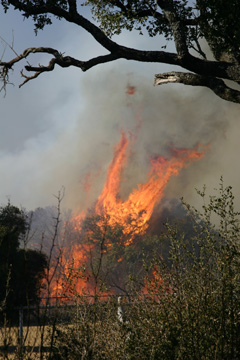 Organizations like Texas Interfaith Power and Light aren’t waiting for the state or federal government to act on global warming — though they think that needs to happen. Working with religious congregations across the state and with similar groups in other states, Moorhead said, Texas Interfaith is helping to educate people about global warming and what they can do about it, teaching them about low-carbon and energy-efficient technologies. In October, Sunday school classes and congregations across the state and country watched Al Gore’s film on global warming, An Inconvenient Truth, “to really raise the issue of religious concerns about global warming,” she said. “It was fantastically successful. Now we’re following up, and the big issue is, ‘Oh my gosh, what can I do?’” Many people in her group and others, she said, will take part in a rally at the Texas Capitol on Feb. 11-12 to “Stop the Coal Rush.” Nan Hildreth, the Houston global warming activist and volunteer, said she set out originally to “make the mayor of Houston say ‘global warming’” after a staffer in the mayor’s office told her that the term was verboten. She achieved that goal, and now she continues to spread the word. Hildreth attributes a 39 percent increase in statewide property insurance rates over the last three years to the effects of global warming: “Wildfires, windstorms, droughts, floods, and other climate disasters are eight times more frequent now than when I was born in the 1950s,” she said.
Organizations like Texas Interfaith Power and Light aren’t waiting for the state or federal government to act on global warming — though they think that needs to happen. Working with religious congregations across the state and with similar groups in other states, Moorhead said, Texas Interfaith is helping to educate people about global warming and what they can do about it, teaching them about low-carbon and energy-efficient technologies. In October, Sunday school classes and congregations across the state and country watched Al Gore’s film on global warming, An Inconvenient Truth, “to really raise the issue of religious concerns about global warming,” she said. “It was fantastically successful. Now we’re following up, and the big issue is, ‘Oh my gosh, what can I do?’” Many people in her group and others, she said, will take part in a rally at the Texas Capitol on Feb. 11-12 to “Stop the Coal Rush.” Nan Hildreth, the Houston global warming activist and volunteer, said she set out originally to “make the mayor of Houston say ‘global warming’” after a staffer in the mayor’s office told her that the term was verboten. She achieved that goal, and now she continues to spread the word. Hildreth attributes a 39 percent increase in statewide property insurance rates over the last three years to the effects of global warming: “Wildfires, windstorms, droughts, floods, and other climate disasters are eight times more frequent now than when I was born in the 1950s,” she said.
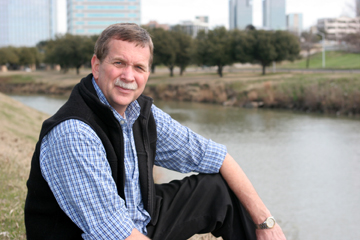 Folks like Hildreth and Moorhead are hoping to influence state leaders in Texas to take action on global warming. But they have less hope of getting anything done in Washington. On the strength of reports that President Bush would address global warming substantively in his state of the union speech, Burnam waited until that day to file his bill. But Bush mentioned global warming only in passing, referring to the “serious challenge of global climate change.” Dessler shares the pessimism about short-term help from Washington. “In 2009, when Bush leaves office, I’m fairly confident that whoever takes office will have a much more progressive attitude … and deal with it in more than the one sentence Bush had in his speech. That’s when we will see the dialogue really start,” he said.
Folks like Hildreth and Moorhead are hoping to influence state leaders in Texas to take action on global warming. But they have less hope of getting anything done in Washington. On the strength of reports that President Bush would address global warming substantively in his state of the union speech, Burnam waited until that day to file his bill. But Bush mentioned global warming only in passing, referring to the “serious challenge of global climate change.” Dessler shares the pessimism about short-term help from Washington. “In 2009, when Bush leaves office, I’m fairly confident that whoever takes office will have a much more progressive attitude … and deal with it in more than the one sentence Bush had in his speech. That’s when we will see the dialogue really start,” he said.
You can reach Gayle Reaves at gayle.reaves@fwweekly.com.











